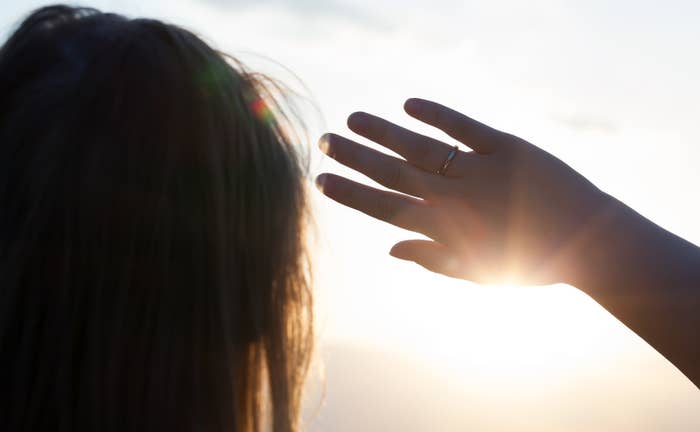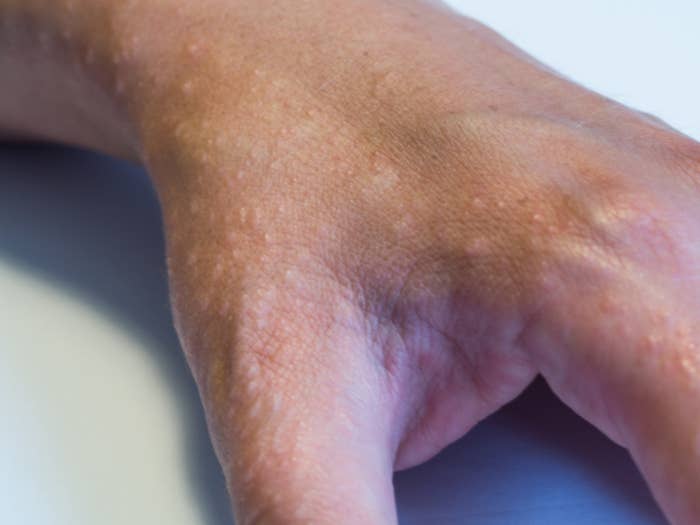
A few years ago I got a diagnosis that made my former goth teen self's heart sing: I'm allergic to the sun.
Well, it's considered more of a sensitivity than an allergic reaction (we'll get to that soon) but it is true that every summer my skin breaks out in tiny, horrible, itchy bumps.
It's called polymorphic light eruption (PMLE), and it's a rash caused by exposure to the sun. And although you can have skin reactions to the sun for a variety of reasons, PMLE is the most common form of photosensitivity. And it's annoying as hell.
It usually starts on the back of my hands and creeps up my arms. Scratching only makes it worse, but it's so itchy that I'll wake up in the middle of the night scratching at my hands. It's also pretty unattractive — one time some jerk at a party commented on my "zombie" hands.
It took several incorrect eczema diagnoses to get to the bottom of the annual summer rash but it turns out PMLE is pretty common. In fact, about 15% of people have it, and it's more common in women in their teens or twenties who have light skin, live in northern regions, and have a family history of the condition.
I asked a dermatologist to break it down.

So first of all, it's not exactly the same as an allergy.
"I don't think an allergy is a good way to think of it at all," said Dr. Whitney High, the director of dermatopathology at the University of Colorado School of Medicine.
It's easy to understand why it gets called a "sun allergy," though. An allergy is the immune system overreacting to the proteins found in something like food, pollen, or pet dander. PMLE, on the other hand, is a photosensitivity, or the body responding to ultraviolet light.
Doctors still aren't completely sure why, but for people with PMLE, ultraviolet light from the sun stimulates an immune response that includes inflammation, swelling, itchiness, and a variety of rashes, including tiny blisters and raised, plaque-like skin.
"Even to this day, while it's very prevalent, we don't know exactly why people get it," said High.
But timing is everything.
The timing of the rash is a big indicator that what's happening is PMLE and not some other skin condition.
"The classic presentation is about four to six hours after you get sunshine, you start to develop swelling and redness," said High.
"It goes on for two or three days with a rash, redness, swelling, itching, things like that. Then the immune system wanes and the skin goes back to the normal."
It also coincides with the start of summer, when we're more likely to get sun exposure. For me, the rash starts around June, gradually getting worse before clearing up by midsummer. That's pretty typical, as it tends to fade with prolonged sun exposure.
But it's not just summer. If I go on vacation to somewhere warm in the winter, I'm guaranteed an outbreak within 24 hours. Not fun.

There's no cure, but you can treat it.
Instead of waiting for the rash to naturally wear off, you can force your body to deal with it. High said he once had a trainee with PMLE who would use ultraviolet lamps to force an outbreak so it would all be over with sooner. (Although keep in mind that tanning beds are associated with a higher risk of skin cancer. While UV lights are used to treat some skin conditions, like psoriasis, talk to your doctor about whether you should use one for PMLE.)
Otherwise, topical corticosteroids are a go-to treatment. Speaking from personal experience, anti-itch cream can also be a lifesaver.
Prevention is also important, which means wearing things like long sleeves and big hats. And while you'd think sunscreen would help, it actually won't do much. It takes so little exposure to set off the rash that sunscreen won't really help, said High.
But the good news is it's not really harmful.
"It's not harmful at all," said High. "It doesn't lead to cancer or infection; you can't pass it on to someone else."
The worst part of it is the appearance, but on the bright side you have an excuse to carry around a parasol. And the risk tends to go down after menopause; some research suggests that it's linked to the female hormone estrogen.
